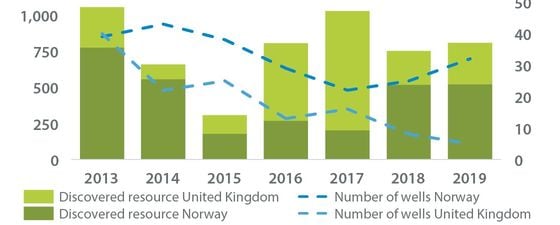ION’s newly reprocessed PSDM 3D seismic data provides the perfect platform to support any renewed oil and gas exploration efforts in Denmark.
With a successful history of 3D proprietary processing, ION is leveraging this vast North Sea experience to produce the highest quality depth product out of the contiguous surveys that make up the Denmark 3D.
Denmark 3D is a multi-client survey that covers about 10,650 km2 of the Danish offshore area, from the Mid North Sea High to the Tail End Graben, in quadrants 5605, 5604, 5603, 5503, 5504 and 5505 of the Danish North Sea.
A) Cross-line through a post stack merge of the Angelina (2007) and South Arne (1995) surveys.
B) ION PSDM Input to VMB down to Base chalk; the survey boundary has been removed and the intra chalk formations are more clearly defined.
C) In-line through the Jill intra chalk target.
D) Zoom in section showing the high resolution imaging of the intra chalk formations, with approximate location of Jill 1 displayed.
The 3D dataset is comprised of multiple contiguous vintage surveys that are currently being reprocessed to create a continuous regional volume from field tapes to PSDM. Phase 1 will be completed in January 2020 and the data shown in this article is an enhanced fast track version, with velocity model building (VMB) complete down to base chalk. The aim of this phase was to combine three different surveys, in order to demonstrate what can be achieved by applying a modern depth processing workflow to existing legacy surveys.
Prior to imaging work, a fully tested pre-processing sequence was applied, incorporating denoise, debubble, deghosting, zero-phasing, shallow water demultiple and regularisation. Special attention was paid to the application of WiBand (ION’s deghosting technique), resulting in a broader frequency range compared to the vintage, and allowing better matching between the three input surveys due to the removal of the source and receiver ghosts.
PreSDM model-building was required to adequately resolve the structurally and lithologically complex subsurface of the project area. This was done in an iterative, top-to-bottom approach, with each iteration addressing specific intervals of a complex anisotropic model. The PreSDM model was built using automatic picking and gridded tomography as well as using full wavefield inversion (FWI) and key horizons at strong impedance boundaries or velocity contrasts in order to better constrain the velocity regimes.
Water depths in the region are around 50m and shallow channels are prevalent, meaning extra care was required during VMB in the shallow section in order to resolve the numerous velocity anomalies. This resulted in a marked improvement in some of the stack distortions seen in previous work.
Two tomographic iterations were carried out for the chalk velocity estimation, with FWI also being incorporated for the chalk and prechalk velocity derivation. The success of the velocity model build is highlighted by a good match at the wells from the area, including Bertel-1. Good matches were also identified with Isak-1, Katherine-1, Nora-1, Ophelia-1, Sten-1 and Svane-1A.
ION’s newly reprocessed PSDM 3D seismic provides the perfect platform to support any renewed exploration efforts in Denmark. This product will be available at an affordable rate and specifically targeted for the licensed and unlicensed acreage west of 6° 15’ E, which can only help stimulate the growth in the Danish offshore.
ION 3D Seismic Data
ION has built on the deep geological knowledge and successes of its SPAN programs to create 3D products unparalleled in image quality. Using the latest geophysical techniques and geological understanding, ION’s 3D programs are changing the multi-client landscape and reducing time to first oil. For more information, visit > https://www.iongeo.com/data-type/3d-data/
More from ION Geophysical
Regional 3D Seismic Offshore Denmark
ION Geophysical
The ION Denmark 3D is a regional multi-client seismic survey, covering approximately 10,650 square kilometres of the Danish offshore area from the Mid North Sea High to the Tail End Graben.
This article appeared in October, 2019





